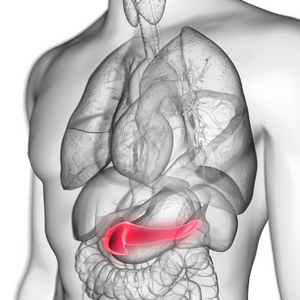Acute Pancreatitis

Acute pancreatitis is characterized by sudden onset of inflammation of the pancreas, a large gland located behind the stomach. The inflammation can cause severe abdominal pain, often radiating to the back or chest, and other symptoms such as nausea, vomiting, and fever. Acute pancreatitis can be caused by several factors, including alcohol abuse, gallstones, high levels of triglycerides in the blood, and certain medications.
Treatment typically involves hospitalization for supportive care and pain management, and addressing the underlying cause of the inflammation. In severe cases, acute pancreatitis can lead to serious complications such as infection, bleeding, and organ failure.
Causes
- Alcohol abuse: long-term heavy alcohol consumption is a common cause of acute pancreatitis.
- Smoking tobacco: also increases risk of acute pancreatitis.
- Gallstones: can block the duct that carries bile from the liver and gallbladder to the small intestine, causing the duct to become inflamed, which can lead to acute pancreatitis.
- High levels of triglycerides: a type of fat, in the blood can cause acute pancreatitis.
- Certain medications: such as sulfa drugs and thiazide diuretics among many others, can cause acute pancreatitis.
- Idiopathic: in some cases, the cause of acute pancreatitis is not known (idiopathic).
- Acute pancreatitis: in some cases can be caused by an underlying medical condition, such as a genetic disorder, high calcium levels, autoimmune inflammation, certain pancreatic cysts, a viral infection, or pancreatic cancer.
Complications
- Infection: the pancreas, bile ducts, or surrounding areas can become infected, leading to sepsis, a potentially life-threatening condition.
- Bleeding: blood vessels in the pancreas can become damaged and bleed, causing blood to accumulate in the abdomen.
- Organ failure: the inflammation and damage caused by acute pancreatitis can lead to failure of the kidneys, lungs, or heart.
- Pseudocyst: a pseudocyst is a fluid-filled sac that can form in the pancreas as a complication of acute pancreatitis. It can cause pain, nausea and vomiting and can become infected if not treated.
- Chronic pancreatitis: acute pancreatitis can lead to chronic pancreatitis, a long-term condition characterized by persistent inflammation of the pancreas and progressive damage to the gland.
- Necrotizing pancreatitis: this is a severe form of acute pancreatitis, characterized by inflammation and death of the pancreas tissue. It can lead to multiple organ failure, sepsis and death.
It’s important to recognize the signs and symptoms of acute pancreatitis and seek medical attention as soon as possible to prevent complications from developing.
FAQs
The most common symptoms of acute pancreatitis are severe abdominal pain, often radiating to the back or chest, nausea, vomiting, and fever. Other symptoms can include rapid pulse, jaundice (yellowing of the skin and eyes), and tenderness in the abdomen when touched.
Acute pancreatitis is typically diagnosed based on the patient’s symptoms and a physical examination. Blood tests, such as a complete blood count and amylase and lipase levels, can be used to confirm the diagnosis. Imaging tests, such as an ultrasound, CT scan or MRI may also be used to confirm the diagnosis and evaluate the extent of the inflammation.
Treatment for acute pancreatitis typically involves hospitalization for supportive care and pain management. This may include intravenous fluids to prevent dehydration, pain medication to control pain, and in cases of severe pancreatitis, nutrition administered by a feeding tube via the nose into the small intestine. The underlying cause of the inflammation should be identified and treated if possible. In severe cases, specialized endoscopy techniques or even surgery may be required to remove gallstones or drain a pseudocyst.
Risk factors for acute pancreatitis include heavy alcohol consumption, gallstones, high triglyceride levels, certain medications, and underlying medical conditions such as genetic disorders and viral infections.
Acute pancreatitis can be prevented by avoiding heavy alcohol consumption, treating gallstones, controlling triglyceride levels, and being cautious when taking medications that can cause pancreatitis. If you have an underlying medical condition that increases your risk of acute pancreatitis, it’s important to manage the condition to reduce your risk of developing the condition.
The prognosis for acute pancreatitis depends on the severity of the condition and the presence of any complications. Most cases of acute pancreatitis, approximately 80-85%, are mild and resolve within a few days with proper treatment. However, severe cases or those with complications can have a more serious outcome, including organ failure and even death in some cases.
Acute pancreatitis can recur if the underlying cause is not identified and treated. For example, if a patient has gallstones that are not removed, they may develop acute pancreatitis again in the future. Additionally, if a patient continues to abuse alcohol, they may develop recurrent episodes of acute pancreatitis.
No, acute pancreatitis is not contagious and cannot be spread from person to person.
Acute pancreatitis or inflammation of the pancreas heals on its own when the body is supported with hydration, nutrition and pain control. Identification and elimination of the underlying cause of the inflammation is very important to avoid additional bouts of pancreatitis. For example, if the inflammation is caused by gallstones, treatment may involve removing the gallbladder (cholecystectomy) to prevent future episodes. If the cause is related to alcohol, the patient should quit alcohol consumption and seek professional help.
During an acute episode of pancreatitis, a diet that is low in fat and easy to digest is usually recommended. You should avoid foods that are spicy, fried or high in fat, and also avoid alcohol.